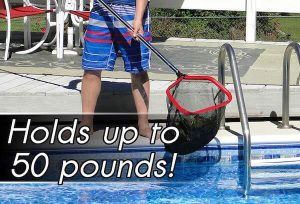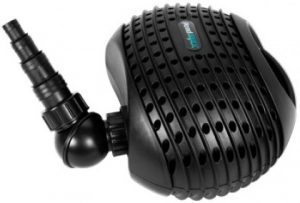How to Choose Pond Pumps, Waterfall Pumps and Pond Filter Pumps
What SIze Waterfall Pond Pump Should You Buy?
3 points determine which Pond, Waterfall, or Filter Pump is needed:
- Purpose of the Pond Pump (circulating the pond water,
powering a Pond Filter, Fountain or Waterfall) - The size of the Pond Pump needed/wanted for the stated purpose
- The type of Pump best suited for the application
Once the size of the pond pump is determined one has the information needed to shop for Pond Pumps. Our (not available on mobile) can help.
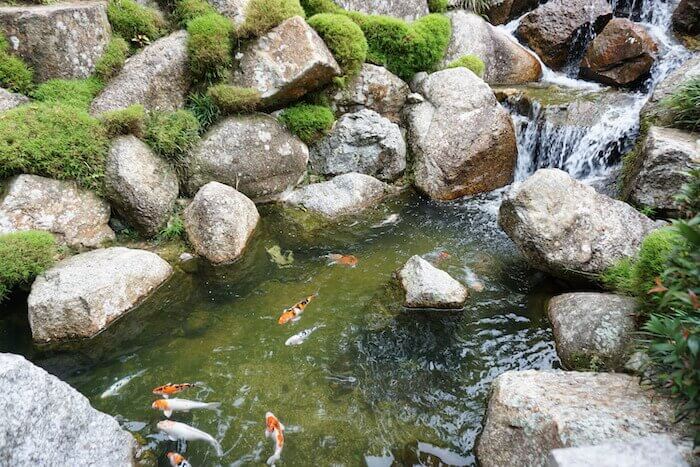
Looking For Aeration Systems?
Read below for further information and a comprehensive guide to choosing pumps as well as an overview of the different types of Pond Pumps, Waterfall Pumps, and Fountain Pumps.
Information about large application Pumps like Aerating Fountains and Aeration systems for large ponds & landscaped lakes, Earth Bottom Ponds, Detention Ponds, and Lagoons, Golf Course and commercial Ponds and Lakes.
To Determine the Size of the Pond Pump Needed:
First, Identify the purpose(s) of the pond pump. For example, is the pond pump responsible for powering a pond filter, a fountain in or around the pond, and/or a waterfall? Answering these questions will help you size the pond pump properly.
Top Selling Pond and Waterfall Pumps
ATTENTION!
If you are looking for a specific pump or ANY item, please email us at info@pondmarket.com and we will send you a direct link for your purchase, even if you don't see it in the store. We are adding products constantly and have much more than what is shown online. We have thousands of products!
A Pump for circulating the Pond Water Only and/or Run a Pond Filter System:
If the pump will be chosen to circulate pond water only, then choose a pump that circulates the pond volume at least once per hour. Calculate pond volume using the following equation: length x width x depth x 7.5 = gallons.
A Pump for powering a Waterfall and/or Waterfall Filter as well as circulating the Pond adequately:
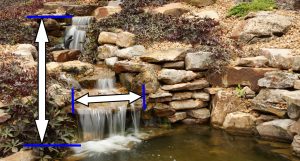
- Sizing a pump for a waterfall involves determining the width the waterfall is, how high up from the pond surface the waterfall starts, and how many feet of tubing will be between the waterfall and pond pump.
- A good rule of thumb is to choose a Waterfall Pump that moves 100 gallons per hour for every inch of Waterfall width.
Select a less powerful Pond Pump for gentle waterfalls and for aggressive waterfalls use a more powerful pond pump. - For example: if the Waterfall is 18 inches wide, an 1800 gallon per hour pump is suited nicely. For a gentler Waterfall, use a 900-1800 gallon per hour Pump and for a more aggressive flow use a 2400-3600 gph Pump. These numbers can be adjusted for any waterfall size.
- Selecting a Waterfall Pump is based on not only the flow rate, but consideration must be given to the pump strength needed to deliver the flow rate to the elevation needed.
Example: if the waterfall is 3 feet above the pond surface (measured straight up), and there are 20 feet of tubing in the line, then, the pump will need to deliver the prescribed flow rate at 5 feet.
1 foot of height has to be added to the elevation of the waterfall for every 10 feet of tubing that is in the system. This is defined as "max head" or "total dynamic head" and is explained in detail below. In most cases, if a pump is sized for a waterfall it will also be strong enough to circulate the water at a rate that keeps the pond clean. Occasionally, depending on the type of filter being used, the pump needed for a waterfall is too large for the pond filter and a second smaller pump may be needed to power the pond filter separately. See below for previously published articles on this subject.
Types of Pond Pumps, Waterfall Pumps, and Fountain Pumps
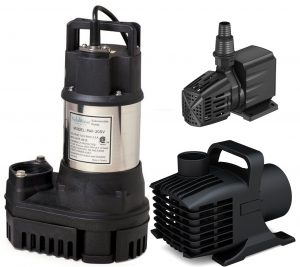 Pond Pumps are re-circulating and most often Submersible Pumps that power Waterfalls, Water Fountains and in garden ponds. Pond Pumps are the heart of the Pond, the main Pond Pump must run 24/7 to keep the Pond Water healthy and oxygenated and should consequently be chosen with care.
Pond Pumps are re-circulating and most often Submersible Pumps that power Waterfalls, Water Fountains and in garden ponds. Pond Pumps are the heart of the Pond, the main Pond Pump must run 24/7 to keep the Pond Water healthy and oxygenated and should consequently be chosen with care.
Pond Pumps, Fountain Pumps, and Waterfall Pumps have to be engineered for continuous duty (as opposed to a Sump Pump, for example, which only runs intermittently). Energy efficiency and durability are very important because Pond Pumps have to run continuously for many months. In many koi ponds, pond pumps run all year. The savings that are realized by buying a low price pond pump could evaporate quickly through higher energy bills as well as the need for frequent replacement of the pump.
900 GPH Vs. 1500 GPH on a 12" Waterfall Spillway
Magnetic drive Pond Pumps are often a good choice because they are energy efficient, compact and durable - but they are not very good at lifting higher than 4 or 5 feet. Direct Drive pumps are better able to lift water to higher elevations and pump very large volumes, but their energy efficiency tends to be lower. Recently, some manufacturer's have designed a new breed of "hybrid" Pond Pumps that utilize the best of the magnet and direct drive to improve both lift and energy efficiency. Hybrid pond pumps utilize magnetic technology with a cupped impeller, therefore, delivering large volumes of water efficiently at low, medium, and semi-high head heights.
How Pond Pumps and Waterfall Pumps are Sized and Maximum Head
Another consideration is the size of the Pond Pump needed to power the water feature of the Pond. Pond Pumps are rated by the gallons per hour (gph) or per minute (gpm) produced at various heights. The top height the pump can lift the water up to is called "Maximum Head" or "Max Head". The "Head" is measured straight up from the water level of the pond. Any horizontal/diagonal flow is then measured by its length and 1' of "Head" added per 10' of horizontal/diagonal distance. At "Max Head" a Pump only produces a thin stream or even drops of water (depending on Pump size).
Waterfall Pumps & Filters
More on Sizing a Pond Pump & Waterfall Pump
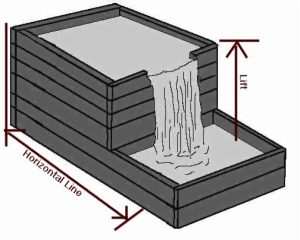 Years ago the prescribed flow rate of a chosen Pond Pump was to be able to circulate the pond at least once every two hours. This was to save on energy consumption and to keep the cost of the pond down. Now, things are more energy efficient, pumps are less expensive, and, circulating the water once an hour (Koi Ponds need to turn over the water once per hour or more often). seems to produce cleaner ponds. This means, for example, that a Pond that holds 500 gallons should be powered at a minimum by a 250-gph Pond Pump. If a Waterfall or pond filter is to be powered with the Pump, then the height and width of the Waterfall and/or the flow rate of the Pond Filter have to be taken into consideration. This can substantially bump the recommended pump size up.
Years ago the prescribed flow rate of a chosen Pond Pump was to be able to circulate the pond at least once every two hours. This was to save on energy consumption and to keep the cost of the pond down. Now, things are more energy efficient, pumps are less expensive, and, circulating the water once an hour (Koi Ponds need to turn over the water once per hour or more often). seems to produce cleaner ponds. This means, for example, that a Pond that holds 500 gallons should be powered at a minimum by a 250-gph Pond Pump. If a Waterfall or pond filter is to be powered with the Pump, then the height and width of the Waterfall and/or the flow rate of the Pond Filter have to be taken into consideration. This can substantially bump the recommended pump size up.
As previously discussed, if a very high or powerful Waterfall is desired and it does not have a Waterfall Filter that accepts high low rates, and a pond filter is to be used, it is often necessary to use a separate pond pump for the pond filter. Many ponds use pressurized filters because they are easy to use and easy to maintain. They are limited by the pump size, therefore, limiting the waterfall flow. This is why many ponds with pressurized pond filters have two pond pumps. Clog resistant pond pumps and magnetic drive pond pumps are best suited for this application.
Clog Resistant and Solids Handling Pond Pumps and Waterfall Pumps
Pond Pumps that are not housed in a pond a skimmer are sometimes subject to clogging due to debris inherent in established Ponds. Manufacturers have taken great pains to design new "clog resistant" and/or "solids handling" Pond Pumps. These pumps are performers and do a great job of reducing the need to clean the Pond Pump. These newer, much more maintenance free Pond Pumps are available both as magnetic drive pumps and direct drive Pumps.
External Pond Pumps
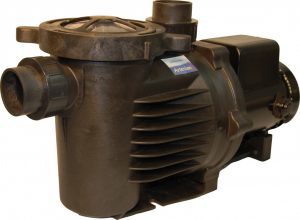
External pumps have advantages, too. Typically used in applications where larger pumps are desired, external pond pumps can be remotely located and use very little power. External, or in-line, pond pumps can be used with pond skimmer filters to draw water from the pond and plumbed to most waterfall spillways or waterfall filters. Higher grade external pumps are very quiet, use very little energy, and last for many years.

